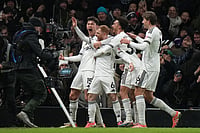
Sarkar was particularly impressed with the architects' ability to integrate the international with the indigenous: "Look at the way they brought out the whole Chinese cultural identity with the bird's nest idea, using the most amazingly modern architectural design."
The K-MoMa idea began to take shape when Buddhadeb Bhattacharya, known to be keen on culture, became chief minister, and Sarkar and other art lovers of the city approached the state for help. But no land was available at the time, nor was a suitable building found for this project. And then something happened. The Picasso Show which came to India in 2006 bypassed Calcutta, because there was no suitable venue for the exhibition. Buddhadeb was supposedly "heartbroken." This time, when Rakhi Sarkar approached him for land, he immediately said yes, and that his government would help in any way possible. They got their 10 acres. But now Sarkar was pushing for more. She said she had two conditions—that the museum would be autonomous and "world-class" because, as she told the chief minister, "We don't want to waste our time doing something your PWD can do." The chief minister gave her the green light.
With the government on their side, the art community now approached the corporate sector, which willingly agreed to invest in the project. The museum's board of trustees includes members of the corporate community, government and three leading artists—Paritosh Sen, Jogen Chowdhury and Ganesh Pyne. And B.M Khaitan, a leading industrialist, is the chairman.
Of the Rs 500 crore the project is budgeted for, roughly Rs 300 crore will be spent on the infrastructure. Though it's being called a modern art museum, it will represent art from the late 18th century, because that is when all the precursory movements to modern art took place. It will also have folk and tribal art, as well as specially designed spaces for installation art. The plan includes setting up galleries for art from India, the Far East, and the West. It will also have a large academic wing, the "backbone" of the museum, providing courses in professional art management and curating, in which India lacks adequate expertise. K-MoMa also plans to host prestigious international art exhibitions.
The liaising with major art organisations across the world has begun, as has the process of hiring expertise, and building up the museum's core collection. Last heard, Herzog and de Meuron were in Switzerland working on the museum's design, and their model is expected to be finalised by January 2009.





















